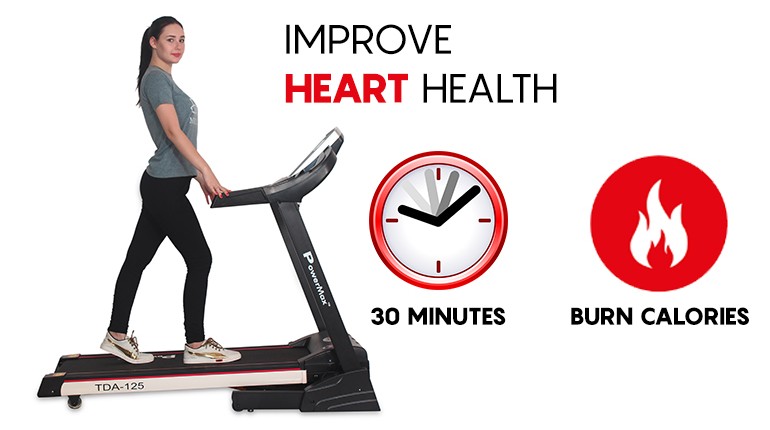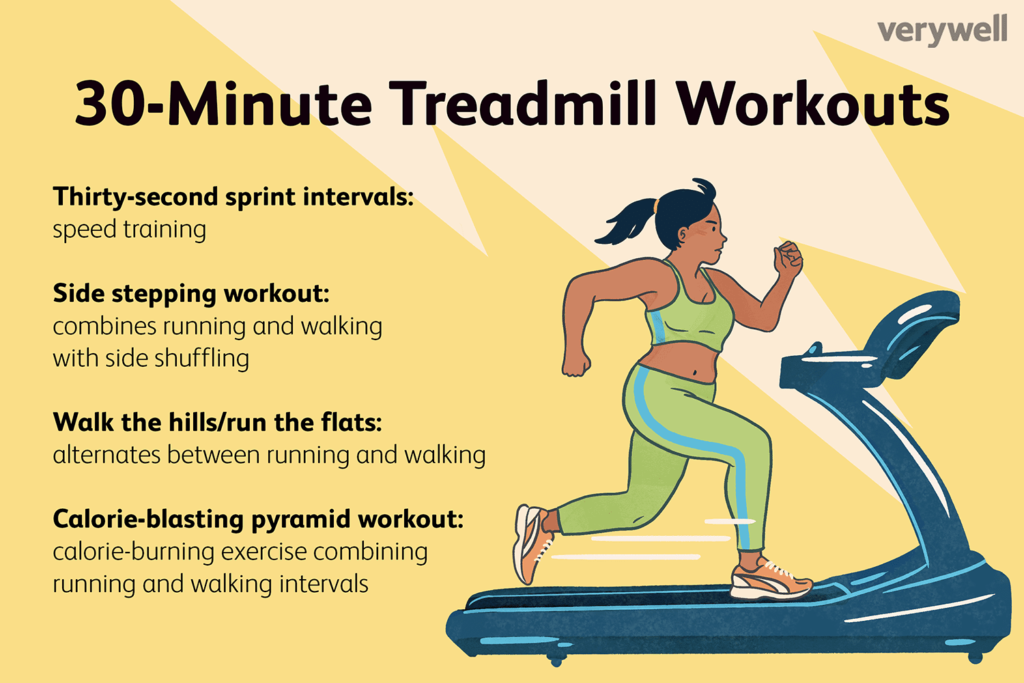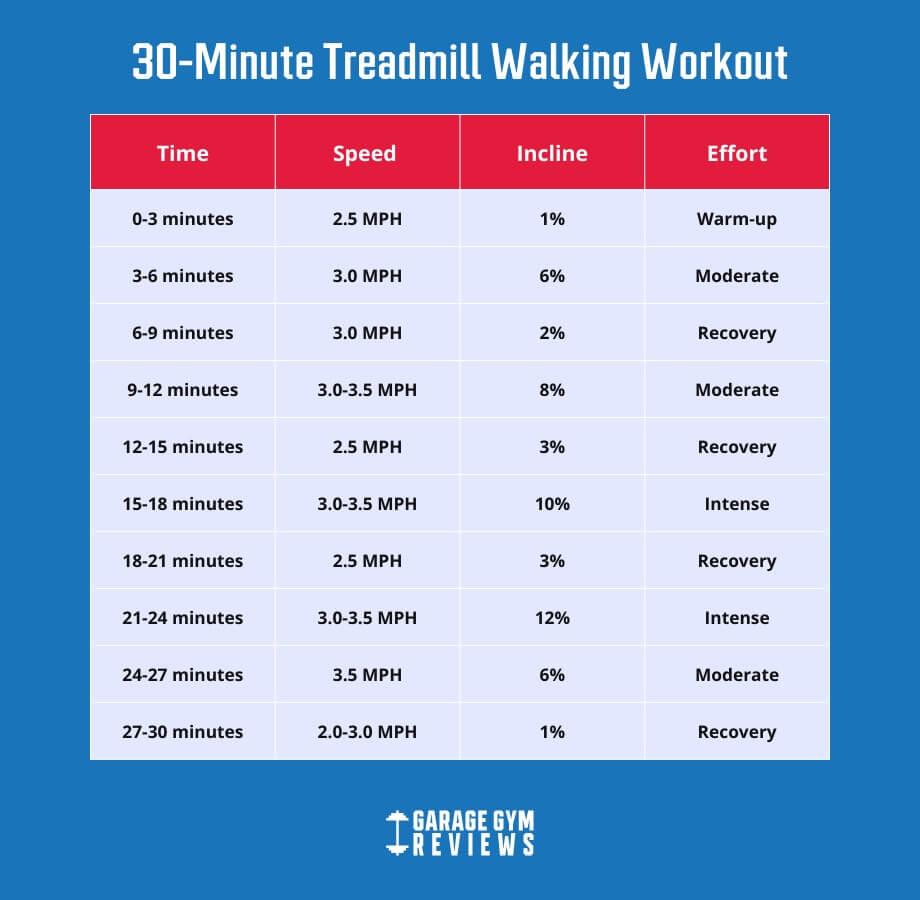Imagine a world where you could improve your health and fitness with just 30 minutes of walking on a treadmill. Sounds appealing, right? Well, in this article, we explore the potential benefits of incorporating this simple exercise into your daily routine. We’ll delve into the various ways that walking for just half an hour on a treadmill can positively impact your physical and mental well-being. So, lace up your shoes and get ready to discover the incredible advantages of this easy and accessible fitness option.
Physical Benefits
Improved Cardiovascular Health
Walking for 30 minutes on a treadmill can have significant benefits for your cardiovascular health. Regular aerobic exercise like walking increases the efficiency of your heart and lungs, improving their overall function. It can lower your resting heart rate, reduce blood pressure, and improve blood flow throughout your body. By increasing your heart rate during exercise, walking on a treadmill helps strengthen your heart muscle, making it more effective at pumping blood and increasing your cardiovascular endurance.
Weight Loss
If you’re looking to shed some extra pounds, Walking on a treadmill can be a great option. Walking is a low-impact form of cardiovascular exercise that helps burn calories and can contribute to weight loss. By walking for 30 minutes on a treadmill regularly, you can create a calorie deficit, which means you’re burning more calories than you consume. This can lead to gradual and sustainable weight loss over time.
Muscle Tone and Strength
While walking may not immediately come to mind when you think about building muscle, it can actually help tone and strengthen various muscle groups, particularly in your lower body. Walking on a treadmill engages muscles in your calves, thighs, glutes, and even your core to a certain extent. By increasing the incline or speed on the treadmill, you can target specific muscles even more. Regular walking can help improve muscle endurance, enhance muscle definition, and increase overall strength in your lower body.
Improved Bone Health
Walking on a treadmill also contributes to improved bone health. Weight-bearing exercises like walking help stimulate the production of new bone tissue and strengthen existing bone structure. This can be particularly beneficial for individuals at risk of or diagnosed with osteoporosis, a condition characterized by weak and brittle bones. Regular treadmill walking can help maintain and improve bone density, reducing the risk of fractures and promoting long-term bone health.
Mental Benefits
Stress Reduction
Walking on a treadmill can be a great way to reduce stress and improve your overall mental well-being. Physical activity releases endorphins, which are natural mood-boosting hormones. These endorphins can help alleviate stress, reduce anxiety, and improve your overall mood. Taking a break from your daily routine to walk on a treadmill can provide a calming and therapeutic effect, allowing you to clear your mind and focus on yourself.
Improved Mood
In addition to reducing stress, walking on a treadmill can contribute to an improved mood. Physical activity releases neurotransmitters like dopamine and serotonin, which are known as “feel-good” chemicals. These neurotransmitters can help elevate your mood, boost your self-esteem, and reduce symptoms of depression. Regular treadmill walking can provide a natural mood enhancement, helping you feel more positive and content throughout the day.
Boosted Energy Levels
If you often find yourself feeling tired and lacking energy, walking on a treadmill can be an effective way to boost your energy levels. Engaging in physical activity increases blood flow, oxygenates your muscles, and improves overall circulation. This can result in increased energy levels and improved focus and concentration. Taking a brief walk on a treadmill during your day can provide a natural energy boost, helping you feel more alert and revitalized.
Increased Cognitive Function
Walking on a treadmill has been linked to improved cognitive function. Regular aerobic exercise, like walking, enhances blood flow to the brain, which can improve memory, attention span, and overall cognitive performance. It has also been shown to reduce the risk of cognitive decline and age-related cognitive disorders, such as Alzheimer’s disease. By incorporating regular treadmill walking into your routine, you can support brain health and preserve cognitive function as you age.
Disease Prevention
Reduced Risk of Chronic Diseases
Regular exercise, including walking on a treadmill, can play a crucial role in reducing the risk of chronic diseases. Physical activity helps manage and prevent various health conditions, including heart disease, type 2 diabetes, and certain types of cancer. Walking on a treadmill regularly can improve cardiovascular health, regulate blood sugar levels, and contribute to maintaining a healthy weight, all of which can lower the risk of chronic diseases.
Controlled Blood Pressure
High blood pressure, or hypertension, is a common issue that can lead to serious health complications. Walking on a treadmill can help control and manage blood pressure levels. Aerobic exercise, like treadmill walking, can reduce systolic and diastolic blood pressure, contributing to overall cardiovascular health. Regular exercise can also improve blood vessel function and reduce arterial stiffness, both of which are important factors in maintaining healthy blood pressure.
Lowered Risk of Stroke
Stroke is a life-threatening condition that occurs when blood flow to the brain is disrupted. Walking on a treadmill can help lower the risk of stroke by improving cardiovascular health, reducing blood pressure, and improving overall circulation. Regular aerobic exercise has been shown to decrease the risk of stroke, making treadmill walking an effective preventive measure.
Improved Blood Sugar Control
If you have diabetes or are at risk of developing diabetes, walking on a treadmill can help improve blood sugar control. Physical activity can increase insulin sensitivity, allowing your cells to more effectively utilize glucose for energy. Regular treadmill walking can also help regulate blood sugar levels, reducing the risk of complications associated with diabetes and promoting overall metabolic health.
Enhanced Fitness
Increased Endurance
Walking on a treadmill regularly can lead to increased endurance and stamina. As you continue to walk for 30 minutes on a treadmill, your body adapts to the exercise, making it more efficient at utilizing oxygen and energy. This increased efficiency allows you to walk for longer durations and distances without feeling fatigued. Improved endurance can benefit various aspects of your daily life, from climbing stairs with ease to participating in sports or recreational activities.
Improved Flexibility
While walking may not be traditionally associated with flexibility, walking on a treadmill can actually contribute to improved flexibility. Regular treadmill walking helps maintain and increase the range of motion in your joints, particularly in your hip flexors, calves, and ankles. Walking on a treadmill can also help stretch and elongate your muscles, improving overall flexibility and reducing the risk of muscle imbalances or stiffness.
Better Balance and Coordination
Walking on a treadmill can enhance your balance and coordination. Walking on an even surface like a treadmill requires a certain level of coordination and stability from your muscles and joints. Regular treadmill walking helps improve proprioception, which is your body’s awareness of its position in space. This increased proprioception can contribute to better balance and coordination, reducing the risk of falls and injuries in everyday life.
Elevated Metabolic Rate
Walking on a treadmill can help elevate your metabolic rate, increasing the number of calories you burn at rest. Regular aerobic exercise, like treadmill walking, can increase your basal metabolic rate (BMR), which is the number of calories your body burns while at rest. This elevated metabolic rate can result in increased calorie expenditure throughout the day, supporting weight management and overall metabolic health.
Joint and Bone Health
Reduced Risk of Osteoporosis
Walking on a treadmill can help reduce the risk of osteoporosis, a condition characterized by weak and brittle bones. Weight-bearing exercises like walking stimulate the production of new bone tissue, strengthening existing bones and reducing the risk of fractures. Regular treadmill walking, particularly at an incline, helps maintain and improve bone density, ensuring the health and longevity of your skeletal system.
Strengthened Joints
Walking on a treadmill can help strengthen your joints, particularly in your lower body. The repetitive impact and movement involved in treadmill walking help increase the strength and stability of your joints, reducing the risk of joint-related issues such as osteoarthritis. Stronger joints can withstand daily activities and movements more effectively, promoting overall joint health and reducing the risk of injury.
Improved Joint Mobility
Walking on a treadmill promotes improved joint mobility, particularly in your hips, knees, and ankles. Regular treadmill walking helps maintain and increase the range of motion in your joints, preventing stiffness and promoting overall joint flexibility. Improved joint mobility can contribute to better overall movement and reduce the risk of joint-related discomfort or limitations.
Alleviated Joint Pain
Contrary to popular belief, walking on a treadmill can actually help alleviate joint pain for many individuals. Walking is a low-impact exercise that puts less stress on your joints compared to higher-impact activities like running. The cushioned surface of a treadmill also provides additional support and shock absorption, reducing the impact on your joints. Regular treadmill walking, especially at a moderate intensity, can help relieve joint pain and improve joint function.
Convenience and Accessibility
Indoor Exercise Option
One of the major advantages of walking on a treadmill is the convenience and accessibility it offers. Treadmills can be used indoors, allowing you to exercise regardless of external weather conditions or time of day. You can easily set up a treadmill in your home, making it easily accessible for daily use. This eliminates the need to travel to a gym or deal with potential safety concerns associated with outdoor walking.
No Weather Constraints
Walking on a treadmill eliminates any weather constraints that may hinder your outdoor exercise routine. Whether it’s extreme heat, freezing temperatures, rain, or snow, a treadmill allows you to maintain your walking routine without worrying about outside conditions. This ensures consistent and uninterrupted exercise, regardless of the climate.
Suitable for All Fitness Levels
Walking on a treadmill is suitable for individuals of all fitness levels. Whether you’re a beginner or an experienced exerciser, the speed, incline, and duration of your treadmill walk can be adjusted to match your fitness level and goals. Treadmills typically offer a wide range of speed and incline options, allowing you to gradually progress and challenge yourself as you become more comfortable and fit.
Availability at Most Gyms
Treadmills are a staple piece of equipment found in most gyms and fitness facilities. This availability makes it easy to incorporate treadmill walking into your exercise routine, whether you prefer working out in a gym environment or have a gym membership. Access to a treadmill at a gym also allows you to take advantage of additional equipment, classes, or professional guidance to enhance your workouts and make the most of your time.
Low-Impact Exercise
Reduced Risk of Injury
Walking on a treadmill is a low-impact form of exercise that puts minimal stress on your joints and muscles. Compared to high-impact activities like running, treadmill walking reduces the risk of injury, particularly for individuals with joint pain or orthopedic conditions. The smooth, cushioned surface of a treadmill absorbs shock and provides support, making it a safer option for those looking to exercise without placing excessive stress on their bodies.
Gentle on Joints
Treadmill walking is gentle on your joints, making it an ideal form of exercise for individuals with joint issues or physical limitations. The low-impact nature of walking on a treadmill reduces the strain on your joints, particularly in your knees, hips, and ankles. This makes it a suitable option for individuals with arthritis, osteoarthritis, or other joint-related conditions, allowing them to engage in physical activity while minimizing discomfort or potential exacerbation of symptoms.
Suitable for Those with Physical Limitations
Treadmill walking can be an excellent form of exercise for individuals with physical limitations or those recovering from injuries. The controlled environment of walking on a treadmill allows for better stability and support compared to outdoor walking. The speed, incline, and intensity of the workout can be customized to accommodate specific needs and limitations, ensuring a safe and effective exercise experience.
Gradual Progression of Intensity
One advantage of walking on a treadmill is the ability to gradually progress the intensity of your workouts. Treadmills often offer different speed and incline settings, allowing you to increase the challenge as you become more fit and comfortable. This gradual progression can help prevent plateaus, promote consistent improvement, and ensure that your workouts continue to challenge your cardiovascular system and muscles.
Weight Management
Calorie Burning
Walking on a treadmill can contribute to calorie burning and weight management. The number of calories burned during a treadmill walk depends on various factors such as your weight, speed, and duration of the workout. However, on average, a 30-minute treadmill walk can burn approximately 150-300 calories. By incorporating regular treadmill walking into your routine, you can create a calorie deficit and contribute to weight loss or weight maintenance.
Appetite Suppression
Engaging in physical activity, including walking on a treadmill, can help suppress appetite and reduce cravings. Exercise has been shown to regulate hunger hormones, resulting in decreased feelings of hunger and increased feelings of fullness. This can prevent overeating and support weight management efforts. Additionally, the endorphins released during exercise can help improve mood and reduce emotional eating, further contributing to appetite suppression.
Weight Maintenance
Walking on a treadmill can be an effective tool for weight maintenance. By incorporating regular aerobic exercise into your routine, you can balance calorie intake and expenditure, helping to prevent weight gain and maintain a healthy weight. Additionally, regular treadmill walking can help preserve muscle mass, which is important for maintaining a higher metabolic rate and overall metabolic health.
Metabolism Boost
Walking on a treadmill can enhance your metabolism, both during and after the workout. Aerobic exercise, like treadmill walking, increases your metabolic rate, resulting in increased calorie burn during the activity itself. Additionally, the elevated heart rate and increased oxygen consumption during exercise continue to boost your metabolism even after you’ve finished your walk. This post-exercise metabolic boost, known as excess post-exercise oxygen consumption (EPOC), can contribute to burning additional calories throughout the day.
Social Engagement
Opportunity for Social Interaction
Walking on a treadmill can provide an opportunity for social interaction, particularly if you choose to exercise in a gym or fitness facility. You can meet and connect with fellow exercisers, forming new friendships or workout buddies. Engaging in conversation or joining group exercise classes can make treadmill walking more enjoyable and help you stay motivated and accountable to your fitness goals.
Group Exercise Classes
Many gyms and fitness facilities offer group exercise classes that incorporate treadmill walking. These classes provide a structured and motivating environment, allowing you to engage in treadmill walking with the guidance of an instructor and alongside other participants. Group exercise classes can add variety to your workouts, provide additional support and motivation, and make treadmill walking a fun and social experience.
Supportive Exercise Environment
Exercising in a gym or fitness facility that offers treadmill walking can provide a supportive and encouraging environment. Staff members and trainers can offer guidance, support, and expertise, ensuring that you’re using proper form and technique while walking on a treadmill. This supportive environment can help you feel more confident and comfortable, enhancing your overall exercise experience.
Motivation through Accountability
Walking on a treadmill as part of a group or with a workout partner can provide added accountability. Knowing that others are counting on you to show up and participate can be a great motivator to stick to your exercise routine. Social engagement and accountability can help you stay consistent and committed to your fitness goals, increasing the chances of long-term success.
Potential Drawbacks
Boredom
One potential drawback of walking on a treadmill is the perceived monotony or boredom that some individuals may experience. Walking on a treadmill indoors can feel repetitive, especially if you’re performing the same routine every day. To combat boredom, you can vary your speed, incline, or duration of your treadmill walks. Listening to music, podcasts, or audiobooks, or watching TV or movies can also help make treadmill walking more enjoyable.
Inability to Stimulate All Muscle Groups
While walking on a treadmill engages various muscle groups, it may not effectively stimulate all muscle groups. Treadmill walking primarily targets muscles in your lower body, such as your calves, thighs, and glutes. If you’re looking to specifically target and strengthen other muscle groups, incorporating additional strength training exercises or other forms of cardio into your routine may be necessary.
Lack of Outdoor Experience
Walking on a treadmill indoors means missing out on the outdoor experience and fresh air that outdoor walking provides. Outdoor walking allows you to enjoy nature, change of scenery, and natural elements, which can enhance the overall exercise experience. If you prefer the outdoor experience, balancing treadmill walking with occasional outdoor walks can provide the best of both worlds.
Less Variety of Terrain
Walking on a treadmill typically involves walking on a flat, even surface. While this can be advantageous for individuals with joint issues or those looking for a controlled environment, it lacks the variability of outdoor walking. Outdoor walking can expose you to different terrains, such as hills, uneven surfaces, and varying inclines, which can activate different muscles and provide a more challenging workout.
In conclusion, walking for 30 minutes on a treadmill can provide numerous physical, mental, and overall well-being benefits. From improved cardiovascular health and weight management to reduced risk of chronic diseases, walking on a treadmill offers a convenient and accessible way to stay fit and healthy. It can strengthen your muscles, joints, and bones, while also boosting your mood, energy levels, and cognitive function. With its low-impact nature, walking on a treadmill caters to individuals of all fitness levels and can be easily tailored to specific needs or limitations. Additionally, the social engagement and supportive environment provided by treadmill walking in a gym or fitness facility can enhance motivation and accountability. While there may be potential drawbacks, such as boredom or the inability to stimulate all muscle groups, these can be mitigated with creative approaches and a balanced exercise routine. Whether you’re a beginner or an experienced exerciser, walking on a treadmill is a fantastic option to improve your physical health, mental well-being, and overall quality of life.





